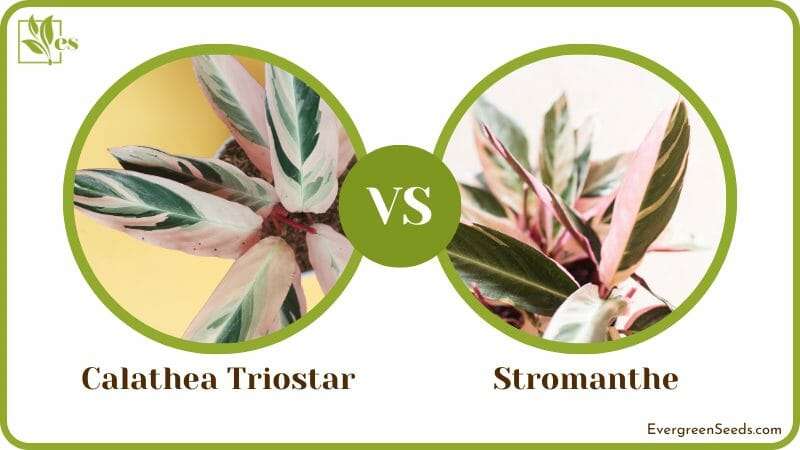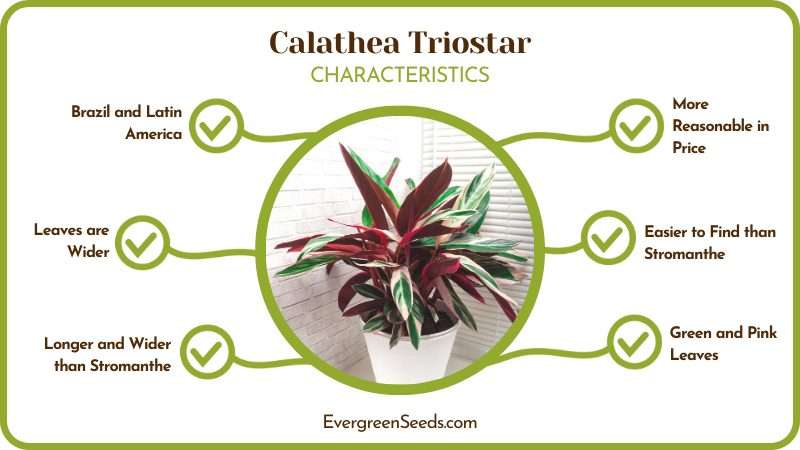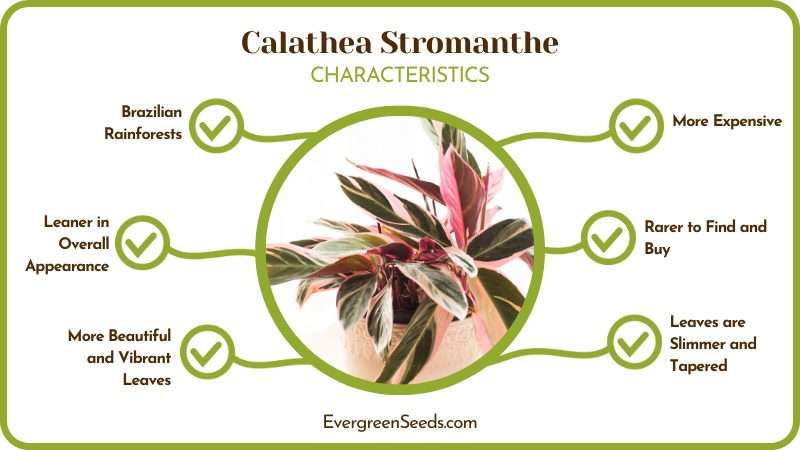Calathea Triostar vs Stromanthe is a question that compounds even seasoned Calathea genus experts. Even though they are separate plants, the similarity between them are seriously uncanny.

We have compiled the most comprehensive list of all the detailed differences between these two beautiful plants of the Marantaceae family.
Read this guide so that you are never confused about Calathea and stromanthe again.
JUMP TO TOPIC
Quick Comparison
Jump below to see a quick table of differences between these two plants.
| Calathea Triostar | Calathea Stromanthe | |
| Native Area | Brazil and Latin America | Brazilian rainforests |
| Leaf Shape |
|
|
| Leaf Variegations |
|
|
| Plant Size |
|
|
| Price | More reasonable in price | More expensive |
| Ease of Purchase | Easier to find than stromanthe | Rarer to find and buy |
| Prayer Position | When this plant closes its leaves at night in prayer position, both the pink and the green are visible. | When the leaves of the plant close at night in prayer position, the pink is completely hidden and only the green is visible. |
What Are the Differences Between Calathea Triostar vs Stromanthe?
The main difference between stromanthe triostar and Calathea is that the leaves of stromanthe are oval and thinner than Calathea’s.
They have more pink than green, and when their leaves close in prayer position, the pink completely disappears. Stromanthe sanguinea are also more difficult to find than Calatheas.
What Is Calathea Characteristic For?
Calatheas are best for keeping as indoor living plants because of their simple care needs. They ae also good for cleaning the air and propagating so that you can gift them to all your friends as well. Continue reading to learn more about these benefits.
– Air Purification
These are great indoor plants for air purification. Their leaves have numerous pores in them that take in carbon dioxide from the air and secrete oxygen back into it. Not only this, but they also absorb minute quantities of toxins that might be floating about in the air.
We really recommend putting one or two of these plants inside your house. They will make the air you breathe fresher and healthier.
– Calathea Triostar Plant Care
The salient points of prayer plant requirements includes a shaded or a semi-shaded location and 65 to 85 degrees Fahrenheit temperatures. They are fantastic plants to keep indoors in this regard.

Water them with moderate quantities of clean, filtered water. It is best not to allow their soil to get dry. At the same time, don’t water so much that the soil ends up turning into mud.
As tropical plants, they have humidity demands reaching up to 65 percent. When the soil and air are allowed to get to dry, you will notice the leaves of your triostar turning brown and wrinkly. During the growing months, a mild and diluted fertilizer every two weeks will produce the lushest foliage.
– Calathea Propagation
Calatheas are good for propagation because of how rare they are to find. You need to learn how to propagate them if you want to keep them for a long time. Here is how you can go about propagating this prayer plant.
- This plant is best propagated using rhizome divisions. In order to carry this out, you must take the plant out of its pot first. Spring is the time when we always propagate ours.
- After removing the plant from its pot, take a look at its rhizomes. Each rhizome will have its own root system along with stems and leaves. You need to separate them from one another.
- Often, rhizomes are easily separated by hand. At other times, you might need to cut them off using a clean knife.
- Take these separated rhizomes and plant them in new soil and a new pot. Take the pot to a bright shaded place and look after it with special care until it becomes used to its new home. Your propagation is now complete.
– Prayer Position
This plant is also called the prayer plant because of one unique property. Its leaves tend to fold inwards and close together at dawn. At sunrise, after getting the stimulus from light, they open right back up. This phenomenon is no doubt breathtaking and is an amazing sight to see every day.
What Is Stromanthe Characteristic For?
The Stromanthe triostar is best for adding some color to your house and propagating through rhizomes. Their care guide is also pretty simple. Carry on reading to find out more.

– Great Ornamental Value
Stromanthe is known in the world for its vibrant pink and green foliage. Its leaves open at sunrise and close at sunset, making this plant quite a dynamic visual treat. There isn’t a more suitable plant to transform a dull interior into a most lively one.
– Triostar Stromanthe Care
Strmanthe triostar care is as straightforward as it gets. First of all, you need a nutrient-rich and well-draining soil mix to pot it in. This plant grows best under filtered or partially shaded sunlight. Just keep away from head-on sunlight or the leaves will end up turning yellow.
The temperature range for this plant is 65 to 80 degrees Fahrenheit, and the air humidity is at least 50 percent. Water regularly when the top inch of the soil starts to feel dry to the touch.
The potting soil needs to have satisfactory drainage of water from it. Adding peat or sphagnum moss to it greatly aids in some much-needed moisture retention.
– Stromanthe Propagation
The stromanthe triostar plant is best propagated using divisions. Early to late spring is the time of the year most suited for this endeavor. Firstly, clean and sterilize your gardening tools and have new pots and soil ready.
Remove the adult plant from its old pot and wash away the soil stuck to the roots. You will see a lot of rhizomes from which stems and roots are growing. Carefully untangle them from each other using your hands or a knife if they need to be cut.
Each separated rhizome should have its own roots and stem with one to two leaves. Repot them all in their new pots and take care of their cultural needs.












